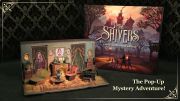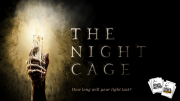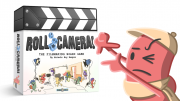The Shivers (Andy Logan) – In a truly unique twist on the escape room genre, The Shivers is a pop-up mystery adventure game, with modular boards so that between each episode you can swap out story cards, which change the clues and secrets of a room, as well as which rooms you are even playing with, to create different experiences and puzzles. Each player also plays a character with their own unique skills. There are six different rooms included in the base game, filled with traps, secret doors, and cabinets, all of which can be interacted with and physically opened, and there are eight different stories to play through.
Casual Games on Kickstarter: Pop-Up Puzzles, Catapults, and Candlelight

July brings some truly unique gaming experiences to Kickstarter, from the innovative mechanics of a pop-up puzzle game to the original atmosphere of a tile placement game in which players are prisoners trapped with only enough light to illuminate the tiles directly adjacent to them. There is also a game of smashing castles with catapults, a solo puzzle game, and a cooperative movie making board game. Throw on top of all this a game designed by Reiner Knizia, and you know it’s a strong month for casual games on Kickstarter.
Catapult Kingdoms (Vesuvius Media) – Each player takes the five troops and fourteen breaks of their chosen army, as well as a player board. You place your board in front of you and then using the bricks, you build a castle on the board, on whatever shape you like so long as the bricks lie flat. You then place your troops, either near or on your castle. Finally you take a catapult and place it to the left or right of your player board. On your turn you may play one of your five action cards (each card may only be played once during the game) these allow you to do things such as move some of your bricks or steal an action card from another player. You can then reposition your catapult to the left or right of your tower, and may then fire one of the boulder game pieces from the catapult and attempt to hit your opponents' troops. Any troops that have been knocked down are removed from the game, as are any bricks that have been knocked off the player board. The last player to have any troops left in the game wins.
The Night Cage (Smirk & Dagger/Smirk & Laughter) – In this cooperative tile placement game, each player is a prisoner, trapped with only a candle. The collective candlelight is represented by the stack of tiles. If you run out of tiles then your light goes out and you lose the game. Each player's candle is considered to only illuminate the passages directly adjacent to their player tokens; meaning that when you move, new tiles will be placed on the board, while tiles that are now outside of the range of your candlelight are removed. Some tiles hold monsters, which will force tiles to be discarded if players are attacked by them. The board is considered to wrap around itself, meaning that you may move off one edge to reach the opposite edge. To win the game you must each collect a key from separate key tiles and then make your way to the same gate tile to escape. If too many keys or gate tiles are lost in the darkness, you also lose the game.
Whale Riders (Grail Games) – Designed by Reiner Knizia, in Whale Riders players are whale riding traders, collecting goods as they progress up and down the coast and fulfill contracts. On your turn you take two of five actions (you may choose to take the same action twice). You may move your whale rider one space up the coast (when you reach the far end, you turn your whale rider around and will head to the other end; once you reach that side you may no longer take this action). You may buy one tile at the location your whale rider currently occupies (the price is determined by the tile’s placement in its row ranging from being free to costing three coins). You make take a gold coin. You may discard contract cards. And you may fulfill a contract card from your hand, discarding the goods tiles depicted on the card.
Dollars to Donuts (Crafty Games) – The goal of the game is to fill your player mat with as many matching donuts as possible. Matching donuts are worth more points based on the type of donut they are. Donuts that do not match earn you dollar tokens. On your turn you may spend dollars to purchase donut tiles which you then add to your player mat, attempting to match the donut halves on the new tile with donut halves on tiles already on the board. While a portion of a tile can reach outside of the mat, you do not score points for any donut matches that fall outside of your player mat. Additionally, there are customer cards on the table, with each customer requesting you to complete certain types of donuts in order to score extra points.
Relics of Rajavihara (Joe Slack) – In this solo puzzle game, you play as an adventurer who has discovered an ancient temple and must make your way through it to collect treasure and defeat your archnemesis. There are fifty levels of increasing difficulty, each with a layout and a goal you must complete in order to proceed to the next one. You move your adventurer orthogonally (but never diagonally) from one space to another; you may climb up and down a block that is one level higher or lower than you are. You can push a block one square away from you (without moving your adventurer) as long as there is nothing to block it. If you push a block with something else on top of it (for example another block), what is on top will fall to the space it just occupied. You cannot pull or lift a block. As you proceed through the game you unlock different types of blocks, each with their own special rules.
Roll Camera! (Keen Bean Studio) – This is a cooperative dice game, in which players are working together to make a movie, by filming five scenes under budget and within schedule, and either create a movie of high enough quality or one that is bad enough to be so bad it’s good. Every turn a problem card is drawn. You then roll your dice, with each dice representing a crew member on set. You spend dice to build set pieces to match the sets shown on the story board cards available to your team, and then fill the set pieces with the cast and crew the story board card requires. You can also spend dice to resolve the problem cards or to have a production meeting during which players can play their idea cards which give them helpful bonuses throughout the game.
Disclosure: unless otherwise noted, we have not seen or played any of the above games. Our assessment of each is based on the information given on the crowdfunding project page.
















